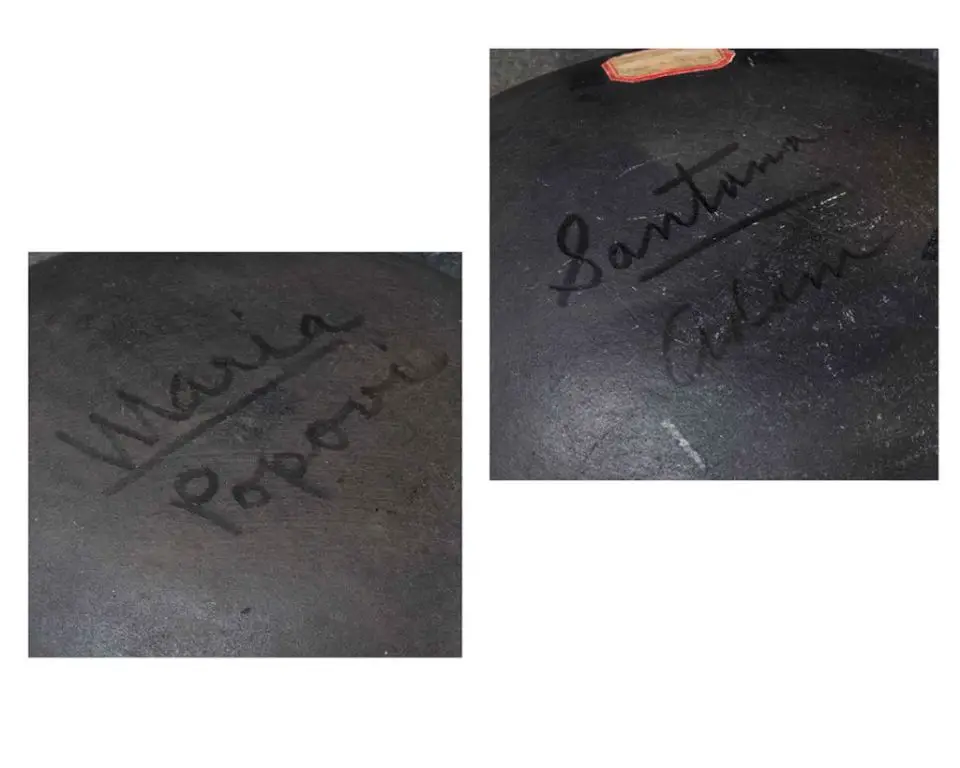What Does The Black Line On Mccarty Pottery Mean?
Maria Martinez was one of the most well-known Native American potters of the 20th century. Born in 1887 in San Ildefonso Pueblo, New Mexico, she came from a long line of Pueblo potters who created earthenware vessels using traditional techniques. Pueblo pottery-making dates back centuries and continues as an important tradition among Pueblo Indians today.
The traditional Pueblo pottery style involved hand-coiling pots from clay and painting them with mineral pigments, creating geometric designs. Maria learned these methods from her aunt, but she innovated upon the tradition by developing new techniques that produced thinner-walled pots with more polished finishes. She also introduced new shapes and refined painting styles that made her pottery highly desirable.
One of Maria’s most iconic innovations was adding a bold black line on the rim of her pots – a striking new element in the traditionally earth-toned Pueblo palette. This minimalist line became a signature of her work and is the defining characteristic of what’s now known as “black-on-black” pottery.

Origins of the Black Line
The distinctive black line first appeared on pottery made by Maria Martinez and her husband Julian Martinez in the early 1920s. According to the Denver Art Museum, Maria and Julian created the first black-on-black pottery in the early 1900s (https://www.denverartmuseum.org/en/edu/object/plate). The black-on-black style was influenced by pottery sherds they found at an ancestral Puebloan archaeological site dating back to the 12th-17th centuries.
As described by the Metropolitan Museum of Art, between 1917-1943 Maria shaped the pots and Julian painted the designs, while together they developed the innovative black-on-black technique using traditional methods (https://www.metmuseum.org/art/collection/search/736324). The finishing process involved polishing the pots with a stone to create the signature black glossy surface and accentuate the matte black painted designs.
This pioneering black-on-black style became synonymous with the Martinez name and transformed the pueblo pottery tradition. Maria and Julian masterfully revived the lost black-on-red ware of their ancestors while putting their own modern spin on the ancient artform.
Meaning and Symbolism
The black line on Pueblo pottery carries deep meaning and symbolism related to Native American traditions. According to Pueblo beliefs, the straight line represents rain and lightning bringing water to their arid lands (Palms Trading). The black color is associated with one of the six cardinal directions, which have spiritual significance in their culture. Specifically, black corresponds to the West and the powers of darkness, death, and the underworld.
Maria Martinez, the potter who popularized black-on-black ware, intentionally used these symbols to honor her Pueblo heritage. The lines invoke tribal prayers for rainfall, fertility, and life’s regeneration. They reflect core values within the community. Traditional Pueblo pottery aims to be functional yet imbued with spiritual meaning. The black lines on Maria’s pots and those of her descendants continue this rich cultural tradition.
Maria’s Innovations
Maria Martinez was known for innovating new pottery styles and techniques that shaped the Pueblo pottery tradition. She is credited with developing the black-on-black pottery style, where the entire pot is covered in shiny black paint. This was created using a new technique of burnishing, polishing the surface with a stone while the pottery is still wet to create a glossy finish (The Art, Life, and Legacy of Maria Martinez).
Prior to Maria’s innovations, Pueblo pottery was unpainted and matte. Maria began experimenting by using mineral and vegetal pigments to paint her pottery black. At first she painted simple linear designs, but eventually covered the entire vessel to make striking solid black pottery. This innovative black-on-black style became Maria’s signature (Puebloan: Maria Martinez, Black-on-black ceramic vessel).
In addition to the black-on-black technique, Maria also introduced new polished redware and polychrome painted styles. Her inventiveness and flair for eye-catching pottery revitalized the art form and made it appealing to a wider audience.
Spreading Popularity
Maria Martinez and her husband Julian Martinez were instrumental in spreading the popularity of black line pottery in the early 20th century. Maria learned how to make pottery from her aunt Nicolasa “YuYo” Montoya Chavez and was inspired to start creating black-on-black pottery after finding pieces of ancient black-line pottery shards. Maria experimented with materials and techniques to try to recreate the style (Black-figure pottery).
In the 1920s, Maria and Julian collaborated with archeologists from the Museum of New Mexico, who wanted to study the old pottery techniques. This brought Maria’s black line pottery to a wider audience. Her work was featured at the Santa Fe Indian Market starting in 1922. Over time, Maria’s innovative black-on-black style became enormously popular not just in New Mexico but across the country, establishing her as one of the preeminent Native American potters of the 1900s.
Identifying Authentic Pieces
As Maria Martinez’s black line pottery has become highly prized by collectors, it’s important to know how to identify genuine pieces. Here are some tips for spotting authentic Martinez black line pottery:
Check for Maria’s hallmark – Authentic black line pots made by Maria will be signed on the bottom with her hallmark, which includes her name and the Pueblo of San Ildefonso. This is the best way to verify it was made by her.
High quality materials and craftsmanship – Genuine black line pottery is made from carefully prepared clay and hand burnished to a smooth, polished finish. The lines and designs are precisely painted with organic pigments.
Traditional shapes and styles – Martinez pieces adhere to time-honored Pueblo forms like jars, bowls, plates, and more. Stylistic elements include birds, feathers, and geometrical designs.
Provenance and history – Documentation showing the pot’s history of ownership and source can help determine authenticity. Genuine Martinez pots usually come from established dealers or collections.
Seek expert opinions – If unsure about a piece, consult with galleries, certified appraisers or the Martinez family to help verify authenticity.
While identifying Martinez work takes some knowledge and research, these tips will help collectors spot genuine black line masterpieces.
Legacy and Influence
Maria Martinez left behind an incredible legacy and influenced generations of Southwest potters. She was a pioneering figure who helped revive traditional Pueblo pottery techniques and styles. Through decades of experimentation and innovation, Maria developed her signature black-on-black pottery which became world famous.
Maria’s pottery was exhibited internationally and she demonstrated her techniques to non-Native artists and anthropologists. This helped spread knowledge of Pueblo pottery traditions to new audiences. According to the NMWA, Maria “almost singlehandedly revived the art of Pueblo pottery making in the twentieth century.”
Many contemporary Native American potters credit Maria as an inspiration. Her family members, including her son Adam Martinez and granddaughter Anna Martinez, have become accomplished potters themselves. Maria revived pottery as a vital art form and economic livelihood for Pueblo communities. Her legacy lives on through the many potters continuing these time-honored traditions today.
Contemporary Pueblo Potters
The black line pottery tradition continues to thrive amongst modern Native American potters in the Pueblos of New Mexico. Though Maria Martinez passed away in 1980, her legacy lives on through family members and students who learned her techniques.
Maria’s son Adam Martinez carries on his mother’s blackware pottery style, signing his pieces “A. Martinez” (“A Gathering: Works from ‘Contemporary Black American Ceramic Artists'”, Northern Clay Center). Other renowned potters from San Ildefonso Pueblo include Lisa Holt and Martinez, granddaughter of Maria and known for her carved blackware pots.
In Santa Clara Pueblo, sisters Lynda and Yvonne Lucas uphold the black line pottery tradition started by their great-aunt Margaret Tafoya. Their pots feature thin walls and polished black surfaces. Other acclaimed Santa Clara potters using black line techniques are Tammy Garcia, Jody Naranjo, and Nancy Youngblood (“6 Black Ceramicists to Support Right Now”, Craft Industry Alliance).
These contemporary Native American artists keep black line pottery designs and methods alive, innovating while honoring their Pueblo heritage and customs.
Collecting Black Line Pottery
Maria Martinez’s innovative black line pottery has become highly coveted by collectors around the world. Here are some tips for collecting and appreciating these special pieces:
Look for authentic pieces with Maria’s hallmark black line and polished black surface. Avoid any pieces that seem hastily made or have messy lines. According to the Denver Art Museum, the black-on-black pottery was so popular with collectors that Maria began signing her pieces with her name, village, and a pictorial hallmark.
Seek out early examples of Maria’s work from around 1920-1940, as these are the rarest and often most valuable. Later pieces from the 1940s-1950s tend to have thicker black lines.
Examine the shape and form – Maria’s innovative shapes became more sculptural over time, evolving from simple bowls to more spherical pots with undulating rims. Look for her signature symmetry and polished finish.
Consider provenance if purchasing for a collection, and look for any available records of previous ownership or sales. Well-documented pieces often fetch higher prices at auction.
Display black line ceramics prominently, allowing the light to bring out the sheen in the finish. Avoid placing near direct sunlight which can cause fading over time.
Handle with care and keep clean – Maria’s pieces are functional pottery yet also works of art. Use archival gloves when handling and dust gently with a soft cloth.
Conclusion
The black line is an iconic design feature of traditional Pueblo pottery. While usually associated with Acoma pottery, it originated with Maria Martinez of San Ildefonso Pueblo in the early 1900s. After rediscovering how to make traditional pottery, Maria innovated by adding bold black lines in matte contrast to the polished surface. This striking and modern aesthetic spread in popularity. The meaning of the black line draws from Pueblo beliefs, symbolizing the spiritual connection between the potter and the clay from the earth. It also emphasizes the balance of forces found in nature. Today, the black line remains a hallmark of authentic Native Southwest pottery from Acoma, San Ildefonso, Santa Clara, Hopi, and Zuni. Master potters continue to incorporate it into their work, simultaneously honoring the traditional methods of their ancestors while expressing their own contemporary artistic visions. The black line’s legacy is seen in the respect it has earned as a premier regional art form collected by major museums and appreciated by connoisseurs around the world.



